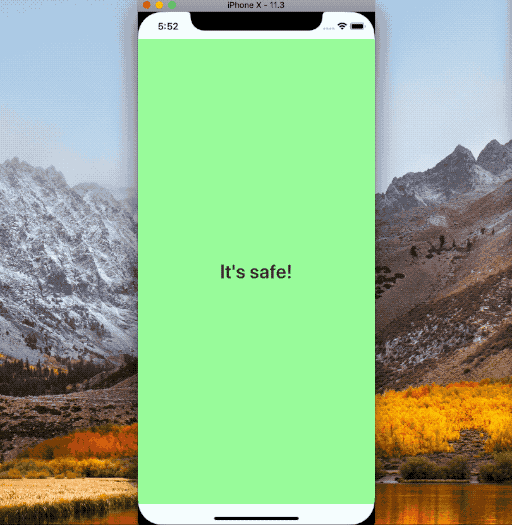React Native module to handle safe area insets natively for iOS 11 or later.
npm install --save react-native-safe-areaYou can link native code in the way you prefer:
Add line to your project target section in your Podfile:
target 'YourProjectTarget' do
+ pod 'react-native-safe-area', path: '../node_modules/react-native-safe-area'
endIf you received error jest-haste-map: Haste module naming collision: Duplicate module name: react-native, add lines below to your Podfile and reinstall pods.
target 'YourProjectTarget' do
+ rn_path = '../node_modules/react-native'
+ pod 'yoga', path: "#{rn_path}/ReactCommon/yoga/yoga.podspec"
+ pod 'React', path: rn_path
pod 'react-native-safe-area', path: '../node_modules/react-native-safe-area'
end
+ post_install do |installer|
+ installer.pods_project.targets.each do |target|
+ if target.name == "React"
+ target.remove_from_project
+ end
+ end
+ endRun command below:
react-native link react-native-safe-areaUse withSafeArea to apply safe area insets to views automatically.
import { withSafeArea } from 'react-native-safe-area'A higher-order component which applies safe area insets automatically to the wrapped component.
component: Component - Wrapped component.applyTo: string - (Optional) Specify property to apply safe area insets.margin-style.margin. (Default)padding-style.padding.absolutePosition-style.top,style.bottom,style.leftandstyle.right.contentInset-contentInsetandcontentOffsetfor scroll views.
direction: string - (Optional) Specify direction to apply safe area insets.top- Apply to top.bottom- Apply to bottom.left- Apply to left.right- Apply to right.topAndLeft-top+left.topAndRight-top+right.bottomAndLeft-bottom+left.bottomAndRight-bottom+right.horizontal-left+right.horizontalAndTop-horizontal+top.horizontalAndBottom-horizontal+bottom.vertical-top+bottom.verticalAndLeft-vertical+left.verticalAndRight-vertical+right.all-horizontal+vertical. (Default)
const SafeAreaView = withSafeArea(View, 'margin', 'all')
class App extends Component<{}> {
render() {
return (
<SafeAreaView>
<View />
</SafeAreaView>
)
}
}const SafeAreaScrollView = withSafeArea(ScrollView, 'contentInset', 'vertical')
class App extends Component<{}> {
render() {
return (
<SafeAreaScrollView>
<View />
</SafeAreaScrollView>
)
}
}You can also apply safe area insets to FlatList and SectionList.
Returns wrapped component's ref.
Returns current safe area insets.
import SafeArea from 'react-native-safe-area'If you want to use SafeAreaInsets type, you can import it like below:
import SafeArea, { type SafeAreaInsets } from 'react-native-safe-area'SafeArea.getSafeAreaInsetsForRootView()
.then((result) => {
console.log(result)
// { safeAreaInsets: { top: 44, left: 0, bottom: 34, right: 0 } }
})class App extends Component<{}> {
// To keep the context of 'this'
onSafeAreaInsetsForRootViewChange = this.onSafeAreaInsetsForRootViewChange.bind(this)
componentDidMount() {
// Add event listener
SafeArea.addEventListener('safeAreaInsetsForRootViewDidChange', this.onSafeAreaInsetsForRootViewChange)
}
componentWillUnmount() {
// Remove event listener
SafeArea.removeEventListener('safeAreaInsetsForRootViewDidChange', this.onSafeAreaInsetsForRootViewChange)
}
onSafeAreaInsetsForRootViewChange(result) {
// Called every time that safe area insets changed
console.log(result)
// { safeAreaInsets: { top: 0, left: 44, bottom: 21, right: 44 } }
}
}A simple example project is here.
